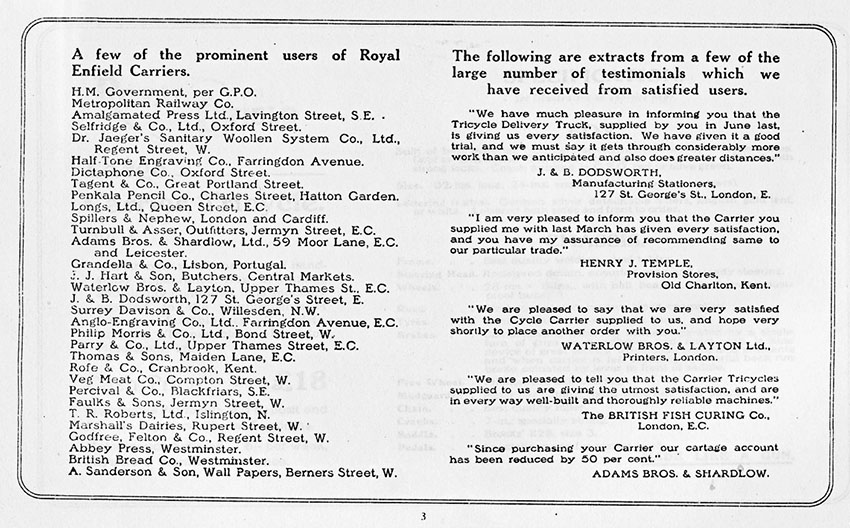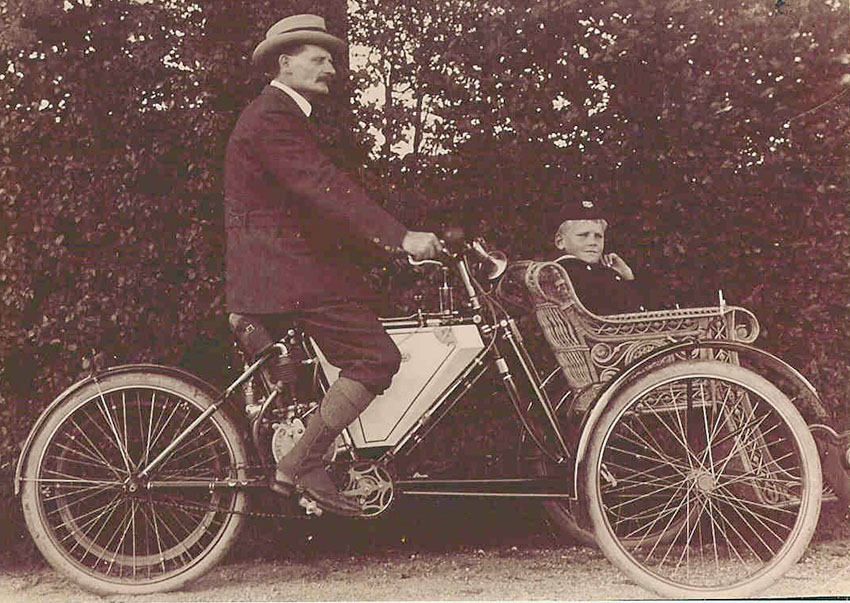
By the turn of the twentieth century, the cycle industry had started creating all sorts of strange contraptions based around bicycles and tricycles, in order to accommodate engines. Everybody knew that motorised quadricycles (‘horseless carriages’) and ‘motor bicycles’ would be the new medium of transport in the new century: bicycles had paved the way, but the initial boom years of the bicycle had started to wane.
There was an increasing demand to carry passengers, without them having to pedal as with a tandem. The first two successful designs that sprang up were those of passenger trailers that could be towed by a bicycle, and tricycles with two front wheels and a wicker seat between them. This latter concept was the most economical way to build a motorised passenger vehicle, as the rolling chassis was already in use as tradesmen’s tricycles. Companies such as Alldays & Onions and Warricks of Reading adapted their chassis to any purpose, as many businesses requiring local delivery trikes had different requirements. So within a few years – though for a short time only – the ‘forecar’ or ‘forecarriage’ or ‘tricar’ or ‘tandem’ became a regular feature of what would soon be called an ‘automobile.’ The vehicle seen here is one of these early passenger tricycles, ie a forecar without an engine.
The Eagle ‘Tandem’ seen in the advert below was a winner at Bexhill race circuit, recently opened in May, 1902 …Great Britain’s first automobile race. The race ran along Bexhill-on-Sea’s ‘Bicycle Boulevard’ which had been built in 1896. (The race ran annually until 1907, when it moved to the new Brooklands circuit).

By 1903, as can be seen in the advert above, the fore car had started to develop automobile features such as independent steering and steering wheel.
Within another year the early forecar would be obsolete, superseded by what was described in the 1899 magazine ‘The Autocar’ as a ‘horseless carriage’ …but was already now being called an automobile.


1904 ROYAL ENFIELD Tricycle Forecar
Based on Royal Enfield’s ‘Large Carrier Tricycle No 1’ Chassis
26″ Wheels
26 x 1 3/4 Tyres
Eadie Coaster Brake
Brooks ‘B90’ Saddle with Toolbag
Full Lighting Set, Inflator Pump, Ding-dong Bell, Lucas ‘No 82’ Rear Carrier
(Now sold)

As you can see from the photos, a lot of care has gone into the factory construction of this passenger-carrying forecar. Although the rolling chassis of the Royal Enfield ‘Large Carrier Tricycle No 1’ was usually fitted to commercial carriers, it was also advertised as being available for any application. The Royal Enfield catalogue announced:
‘We are prepared to undertake the construction of any type of carrier other than standard, and to gratuitously prepare drawings and estimates to customers’ specifications.’
The elaborate, elegant curved springs and shaped wicker seat support suggest that the front end of this forecar was designed for this specific purpose, and that this was not a one-off bespoke build. Nevertheless, I have not come across another example, so presumably they were not manufactured in great quantity, most likely only to a customer’s order.
A standard fitting to most companies’ carrier tricycles is the ‘powerful back rim brake actuated by lever in front of saddle.’ But, in accordance with its special design, the forecar also has an Eadie Coaster Brake. Before being purchased by BSA, the Eadie company was a Royal Enfield concern, so the fitment of an Eadie Coaster Brake is a logical addition. The mudguards are described as ‘Motor car pattern, extra wide and very strong.’ This forecar is fitted with three oil lamps, one to the rear and two to the front.

Compare the catalogue illustration of Royal Enfield’s Selfridge Commercial Carrier with the Forecar; they share the same chassis.


c1911 ROYAL ENFIELD CATALOGUE

















ALLDAYS & ONIONS COMMERCIAL CARRIER TRICYCLE

It’s interesting to compare the Royal Enfield forecar with the 1910 Alldays commercial carrier pictured here.

TO SEE MORE OF THE
1910 ALLDAYS DELIVERY TRICYCLE
PLEASE CLICK HERE









FORECARRIAGE, TANDEM & TRI-CAR CATALOGUE ILLUSTRATIONS

The Ormonde Forecarriage (above and below) was a popular machine.


Royal Enfield introduced a motorised commercial carrier at the 1935 Olympia Show
















JOHN WARRICK OF READING

Although Royal Enfield, Alldays & Onions, Triumph and Elswick established contracts to supply various companies and government utilities with commercial carrier tricycles, John Warrick of Reading was one of the earliest builders, and eventually dominated the market. The Warrick catalogue, below, provides a clear picture of the front end of the bare chassis.
John Warrick had premises at The Butts in Reading as a gunsmith and, in 1877, he took on an agency for ‘The Monarch Carrier,’ a tradesman’s box tricycle made by T.W. Pitt at Caversham Rd, Reading. The new business was so successful that he subsequently gave up the manufacture of guns, moved to Pitt’s Caversham Rd depot, and was turning out trade cycles at a fantastic rate. A first-class engineer, he introduced many new features which became patented. He soon cornered the market in the supply of tradesman’s tricycles and bicycles, which he rented to companies on short-term or long-term contracts.
One of the ways he became a market leader in this field was by supplying his rolling chassis with any style of front end required by the customer. Warricks were also trade suppliers, so other companies could buy a chassis and add their own badges. The machine featured here did not therefore need to be totally built from scratch, but would have been supplied as a ‘cycle carrier’ rolling chassis with a bespoke front end for a passenger.
The advert below illustrates a later model with expanding front brake drums, rather than the earlier handbrake on the rear wheel.

TO READ MORE ABOUT
JOHN WARRICK OF READING
PLEASE CLICK HERE



Bexhill-on-Sea races info thanks to – http://www.discoverbexhill.com/bexhillmotorracing.php
Illustrations of fore cars thanks to Pete – http://occhiolungo.wordpress.com/2012/03/12/forecars/






















































